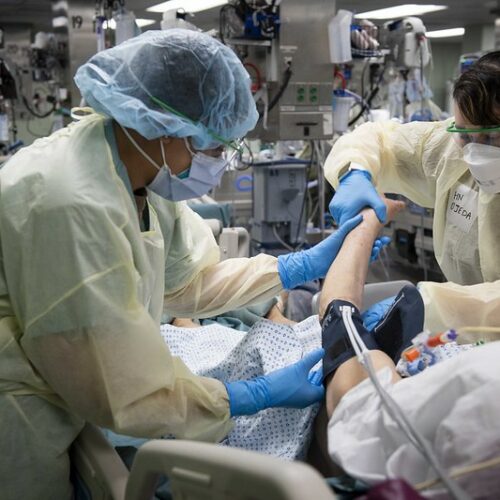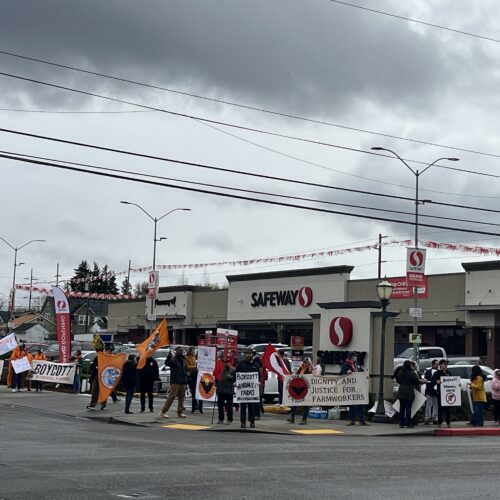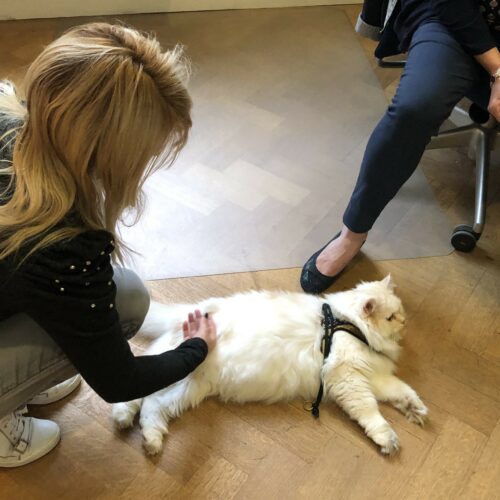
How The Small Business Loan Program Went Wrong In Just 4 Weeks
BY DANIELLE KURTZLEBEN, JIM ZARROLI, LAURA SULLIVAN, CHERYL W. THOMPSON, BILL CHAPPELL, GRAHAM SMITH & PALLAVI GOGOI
Trish Pugh started an Ohio trucking company with her husband in 2015. Even for a small business, it’s small — they had two drivers, counting her husband, until they let one go because of the coronavirus crisis.

Signs are displayed in the window of a store in Grosse Pointe Woods, Mich. The Paycheck Protection Program, aimed at helping small businesses survive the coronavirus crisis, has been beset by problems. CREDIT: Paul Sancya/AP
And so her company applied for a loan under the first, $349 billion round of the Paycheck Protection Program, which the federal government had set up to rescue small businesses.
It didn’t go well.
First, there was confusion between her, her banker and the Small Business Administration over what forms were needed to apply. And then, once she did, she soon found out that she had missed out on the money.
“I click on this website, and it tells me that I have to reapply when more funds are available. I was devastated,” she said.
Not only did that first pot of PPP money run out in 13 days, but self-employed people like Pugh were only able to apply one week after the program opened. That put them well behind other businesses in the first-come, first-served program.
“We’re basically getting ready to lose everything, and it’s really sad because we did this all on our own at first,” Pugh said as she prepared to apply for the second round of the program, which has $321 billion in funding. “Now that we need help, we can’t get help.”
Pugh has since updated NPR that she ended up getting a loan of just over $10,000. It will help, but she’s not sure how much longer that will keep her business running.
Frustrations like Pugh’s have been common since the rollout of the small business rescue program. But her experience was only a sliver of the problems plaguing the PPP in the first round when the program ran out of money and also the shaky launch of the second round. Here’s a list:
Some not-so-small companies, like Shake Shack, got loans
The PPP was created to allow any company with less than 500 employees to get the loans. But several larger businesses that operate with fewer employees in separate locations, under a franchise model, also applied and received loan money. Shake Shack, for instance, employs nearly 8,000 people at its 189 U.S. restaurants, but only around 45 in each location.
So the chain applied and got a $10 million loan from the SBA, prompting a public outcry, especially after mounting evidence that many smaller restaurants who needed the money weren’t able to get loans. Shake Shack promptly returned the money. The company, which has $104 million in cash and liquid assets, said it had secured other loans to cover the money that would have come from the SBA.
Similarly, steakhouse chain Ruth’s Chris Steak House, which has about 5,700 employees, received a total of $20 million and also returned it.
The LA Lakers got a loan, too
Then there were other organizations that aren’t quite what most people would call a small business. Like the Los Angeles Lakers basketball team, the eighth most valuable sports team in the world, worth an estimated $3.7 billion, according to Forbes.
But the Lakers applied and received a $4.6 million small business loan. Once again, after news coverage, the Lakers decided to give it back.
“Once we found out the funds from the program had been depleted, we repaid the loan so that financial support would be directed to those most in need,” the team said in a statement.
Shortly after public outrage over large and well-known businesses grew to a roar, the SBA announced that it would give increased scrutiny to PPP loan applications for more than $2 million.
Banks reaped $10 billion, just in fees
Another huge beneficiary of the small business loan program: banks.
Even as tens of thousands of small businesses were shut out of the program, banks made more than $10 billion in fees, according to an NPR analysis of financial records.
The SBA-guaranteed loans carry very little risk, and the banks were happy to dole out larger loan amounts, which brought in higher fees.
Much of the money went to thriving, not struggling, companies
Large companies, we now know, got loans. Now it appears that companies didn’t have to be struggling to win a loan, either.
Chembio Diagnostics, a company based in Long Island, N.Y., that manufactures infectious disease tests, got nearly $3 million from the program.
It was just the kind of cash infusion the company needed to help grow. “For us to be able to increase our manufacturing capabilities, we thought that having this supplemental dollar amount or loan would be very helpful,” said Gail Page, a Chembio board member and former interim CEO.
The problem is that the program wasn’t designed to help companies grow. It was meant to rescue small companies, nonprofits and self-employed people struggling to make payroll or pay benefits and utilities.
Some small businesses say the loans have too many strings
Business owners lucky enough to get the funding have said the money kept their businesses afloat. However, some owners also said PPP rules are not allowing them to use the money in the ways they see as best.
Among their biggest complaints: 75% of the forgiven amount on the loans must be spent on payroll. The rest can only be spent on a few categories: rent, mortgage interest or utilities.
But with many businesses unable to reopen, owners wonder how to spend that much on payroll when they have little or no work for their employees to do.
“I understand in principle it’s encouraging us to get people back to work,” said Christian Piatt, the co-owner of Brew Drinkery in Granbury, Texas. “But in practice, when you have a retail storefront that is not being allowed by local authorities to operate in the way that we had before, there should be some consideration to make it to account for that.”
Will the loans have to be returned, or will they be forgiven?
Further complicating all of this is that some businesses and financial professionals don’t know if the loans will have to be paid back or forgiven. They have been waiting on further details from SBA about how forgiveness will work.
“In some ways, they really put these small businesses in a very compromising position because they could end up in a situation where they go out and spend dollars to bring people back on the payroll, which ultimately will not be forgiven at the end,” said Don Stevens, managing partner of private client services at accounting firm CohnReznick.
It’s important that businesses understand all of this soon. Forgiveness calculations will be based on how businesses spend their money within eight weeks of receiving it. The program opened on April 3, so there are now about four weeks until the first businesses will have to report their spending to SBA.
And just when you think things couldn’t be worse, the website crashed on the first day that the second round of funding reopened on April 27.
9(MDAyOTk4OTc0MDEyNzcxNDIzMTZjM2E3Zg004))















